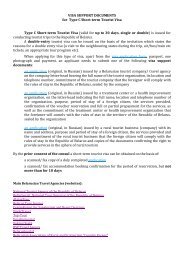Human Development Report 2013 - UNDP
Human Development Report 2013 - UNDP
Human Development Report 2013 - UNDP
You also want an ePaper? Increase the reach of your titles
YUMPU automatically turns print PDFs into web optimized ePapers that Google loves.
Around the worldpeople are calling ongovernments to becomemore accountable tocitizens and to expandpublic opportunities toinfluence policymakingFIGURE 4.3young people cannot find work, they tendto feel aggrieved. Average years of schoolinghave risen over the past 30 years in allcountries with data available. 24 Yet grievancesalone do not trigger upheavals. Thepublic can be angry, but if people believethat the cost in time and effort to engagein political action outweighs the likelihoodof real change, they may not act. 25 Massprotests, especially by educated people, tendto erupt when bleak prospects for economicopportunities lower the opportunity cost ofengaging in political activity. These “effortintensiveforms of political participation” 26are then easily coordinated through newforms of mass communication.Around the world people are calling ongovernments to become more accountable tocitizens and to expand public opportunities toinfluence policymaking. Such transformationshave taken place in the past. For example, KarlPolanyi documented the Great Transformationof 1944, where governments in the NorthAt each HDI level, some countries have greater carbon productivity than othersCarbon productivity, 2008 (PPP $ per kilogram)4030201000.275 0.375 0.475 0.575 0.675 0.775 0.875 0.975Low HDIMedium HDINote: Carbon productivity is GDP per unit of carbon dioxide. PPP is purchasing power parity.Source: HDRO calculations based on World Bank (2012a).High HDIHDIVery high HDIresponded to demands from civil society andlabour unions to regulate the market and extendsocial protection so that the market servedsociety rather than society being subservient tothe market. 27 Many governments introducedregulations to constrain the activities of firmsand improve working conditions and extendedsocial services and social protection.Governments also assumed power over macroeconomicpolicy and introduced some restrictionson international trade. The time maybe right again for a transformation, appropriatefor 21st century concerns and conditions. 28Confronting environmental pressuresA major challenge for the world is to reducegreenhouse gas emissions. While it might seemthat carbon productivity (GDP per unit of carbondioxide) would rise with human development,the correlation is quite weak (figure 4.3).At each HDI level, some countries have greatercarbon productivity than others.Consider medium HDI Guatemala andMorocco, countries with nearly identicalHDI values. Guatemala’s carbon productivity($5.00 per kilogram in purchasing power parityterms) is nearly twice that of Morocco ($2.60).Differences can be just as great among provincesor states within countries, as in China. 29 Thesefindings reinforce the arguments that progressin human development need not worsencarbon use and that improved environmentalpolicy can accompany human development.To sustain progress in human development,far more attention needs to be paid to theimpact human beings are having on the environment.The goal is high human developmentand a low ecological footprint per capita (thelower right quadrant of figure 1.7 in chapter 1).Only a few countries come close to creatingsuch a globally reproducible high level ofhuman development without exerting unsustainablepressure on the planet’s ecologicalresources. Meeting this challenge on a globalscale requires that all countries adjust their developmentpathway: developed countries willneed to reduce their ecological footprint, whiledeveloping countries will need to raise theirHDI value without increasing their ecologicalfootprint. Innovative clean technologies willplay an important part in this.94 | HUMAN DEVELOPMENT REPORT <strong>2013</strong>
















